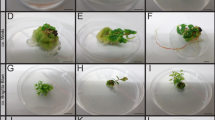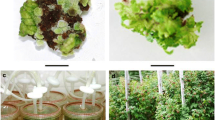Abstract
Adventitious shoot regeneration from leaves of blackberry cultivar Čačanska Bestrna was examined using 30 different combinations of treatment. Young, fully expanded leaves taken from in vitro proliferating shoots were cultured on Murashige and Skoog (MS) medium containing either N 6-benzylaminopurine (BAP) (2.0 mg l−1) or thidiazuron (TDZ) (1.0 and 2.0 mg l−1) alone, or either of them combined with indol-3-butyric acid (IBA), α-naphthalene acetic acid (NAA) and 2,4-dichlorophenoxyacetic acid (2,4-D) at different concentrations (0.1, 1.0 and 2.0 mg l−1). Indirect shoot formation was observed in 12 different treatments, though the efficacy varied greatly among types and concentrations of plant growth regulators. TDZ at 1.0 mg l−1, applied either alone or combined with IBA, was significantly more effective than BAP in inducing shoot regeneration. The highest regeneration rate (41.66%) was obtained on medium containing TDZ alone. Cytological, flow cytometry and isozyme analyses were used for screening of genetic stability/instability in regenerants. Cytological study, based on chromosome counts in root tip meristems, and flow cytometry analysis indicated that adventitious shoots of Čačanska Bestrna are tetraploid with 2n = 4x = 28 as well as those derived from axillary buds. However, a study conducted on the peroxidase patterns of the different blackberry regenerating lines showed differences between some lines and control plants (in vivo plants and micropropagated plants). These differences were visible with 3,3′,5,5′-tetramethylbenzidine (TMBZ) as hydrogenous donor for peroxidase detection.





Similar content being viewed by others
Abbreviations
- BAP:
-
N6-Benzylaminopurine
- 2,4-D:
-
2,4-Dichlorophenoxyacetic acid
- DAPI:
-
4′-6-Diamidino-2-phenylindole
- DNA:
-
Deoxyribonucleic acid
- G0/G1 :
-
Resting phase of normal cell cycle
- GA3 :
-
Gibberellic acid
- IBA:
-
Indole-3-butyric acid
- MS:
-
Murashige and Skoog (1962)
- Na2EDTA:
-
Sodium-2-ethylenediaminetetraacetic acid
- NAA:
-
α-Naphthaleneacetic acid
- PAGE:
-
Polyacrylamide gel electrophoresis
- PGR:
-
Plant growth regulator
- POX:
-
Peroxidase
- Rm :
-
Relative mobility
- TBE:
-
Tris-borate-EDTA buffer
- TDZ:
-
Thidiazuron (N-pheny-N′-1,2,3-thidiazol-5-ylurea)
- TMBZ:
-
3,3′,5,5′-Tetramethylbenzidine
References
Alan AR, Zeng H, Assani A, Shi WL, McRae HE, Murch SJ, Saxena PK (2007) Assessment of genetic stability of the germplasm lines of medicinal plant Scutellaria baicalensis Georgi (Huang-qin) in long-term, in vitro maintained cultures. Plant Cell Rep 26:1345–1355
Al-Zahim MA, Ford-Lloyd BV, Newbury HJ (1999) Detection of somaclonal variation in garlic (Allium sativum L.) using RAPD and cytological analysis. Plant Cell Rep 18:473–477
Ambrožič Turk B, Swartz HJ, Zimmerman RH (1994) Adventitious shoot regeneration from in vitro-cultured leaves of Rubus genotypes. Plant Cell Tissue Organ Cult 38:11–17
Arumuganathan K, Earle ED (1991) Estimation of nuclear DNA content of plants by flow cytometry. Plant Mol Biol Rep 9:229–233
Azeqour M, Majourhat K, Baaziz M (2002) Morphological variations and isoenzyme polymorphism of date palm clones from in vitro culture acclimatized and established on soil in South Morocco. Euphytica 123:57–66
Bennici A, Anzidei M, Vendramin GG (2004) Genetic stability and uniformity of Foeniculum vulgare Mill regenerated plant trough organogenesis and somatic embryogenesis. Plant Sci 166:221–227
Bogani P, Simoni A, Lio P, Scialpi A, Buiatti M (1996) Genome flux in tomato cell clones cultured in vitro in different physiological equilibria. II. A RAPD analysis of variability. Genome 39:846–853
Bošković R, Tobutt KR (1996) Correlation of stylar ribonuclease zymograms with incompatibility alleles in sweet cherry. Euphytica 90:245–250
Cousineau JC, Donnelly DJ (1991) Adventitious shoot regeneration from leaf explants of tissue cultured and greenhouse-grown raspberry. Plant Cell Tiss Organ Cult 27:249–255
Elmaghrabi A, Ochatt S (2006) Isoenzymes and flow cytometry for the assessment of true-to-typeness of calluses and cell suspensions of barrel medic prior to regeneration. Plant Cell Tissue Organ Cult 85:31–43
Fiola JA, Hassan MA, Swartz HJ, Bors RH, Mcnicols R (1990) Effect of thidiazuron, light fluence rates and kanamycin on in vitro shoot organogenesis from excised Rubus cotyledons and leaves. Plant Cell Tiss Organ Cult 20:223–228
Gajdošova A, Ostrolucka MG, Libiakova G, Ondruškova E (2007) Protocol for micropropagation of Vaccinium vitis-idea L. In: Jain SM, Haggman H (eds) Protocols for micropropagation of woody trees and fruits. pp, Springer, pp 457–464
Graham J, Iasi L, Millam S (1997) Genotype-specific regeneration from a number of Rubus cultivars. Plant Cell Tissue Organ Cult 48:167–173
Gupta S, Mahalaxmi V (2009) In vitro high frequency direct plant regeneration from whole leaves of blackberry. Sci Hortic 120:22–26
Klisurska D, Dencheva A (1980) Substrate specifity of peroxidase isoenzymes for hydrogen donors. Biol Plant 22:404–409
Larkin PJ, Scowcroft WR (1981) Somaclonal variation—a novel source of variability from cell cultures for plant improvement. Theor Appl Genet 60:197–214
Lattoo SK, Bamotra S, Sapru Dhar R, Khan S, Dhar AK (2006) Rapid plant regeneration and analysis of genetic fidelity of in vitro derived plants of Chlorophytum arundinaceum Baker–an endangered medicinal herb. Plant Cell Rep 25:499–506
Legkobit MP, Khadeeva NV (2001) Isozyme patterns of acid peroxidase in the genus Stachys. Russ J Genet 37:768–771
Loureiro J, Pinto G, Lopes T, Doležel J, Santos C (2005) Assesment of ploidy stability in the somatic embryogenesis process in Quercus suber L. using flow cytometry. Planta 221:815–822
Meng R, Chen THH, Fin CE, Li Y (2004) Improving in vitro plant regeneration from leaf and petiole explants of ‘Marion’ blackberry. HortScience 39:316–320
Mezzetti B, Savini G, Carnevali F, Moti D (1997) Plant genotype and growth regulators interaction affecting in vitro morphogenesis of blackberry and raspberry. Biol Plant 39:139–150
Murashige T, Skoog F (1962) A revised medium for rapid growth and bio-assays with tobacco tissue culture. Physiol Plant 15:473–497
Nehra BS, Kartha K, Stusnoff C, Giles K (1992) The influence of plant growth regulator concentrations and callus age on somaclonal variation in callus culture regenerants of strawberry. Plant Cell Tissue Organ Cult 29:257–268
Phillips RL, Kaepplert SM, Olhoft P (1994) Genetic instability of plant tissue cultures: breakdown of normal controls. Proc Natl Acad Sci USA 91:5222–5226
Pinto G, Loureiro J, Lopes T, Santos C (2004) Analysis of the genetic stability of Eucalyptus globulus Labill somatic embryos by flow cytometry. Theor Appl Genet 109:580–587
Radić S, Prolić M, Pavlica M, Pevalek-Kozlina B (2005) Cytogenetic stability of Centaurea ragusina long-term culture. Plant Cell Tissue Organ Cult 82:343–348
Ružić Đ, Lazić T (2006) Micropropagation as means of rapid multiplication of newly developed blackberry and black currant cultivars. Agric Conspect Sci 71:149–153
Ružić Đ, Cerović R, Bošković R (1991) The assessment of somaclonal variation in sour cherry cv Šumadinka regenerated from leaf explants. Fruit Sci Rep 18:155–162
Siragusa M, Carra A, Salvia L, Puglia AM, De Pasquale F, Carimi F (2007) Genetic instability in calamondin (Citrus madurensis Lour.) plants derived from somatic embryogenesis induced by diphenylurea derivatives. Plant Cell Rep 26:1289–1296
Škof S, Bohanec B, Kastelec D, Luthar Z (2007) Spontaneus induction of tetraploidy in hop using adventitious shoot regeneration method. Plant Breed 126:416–421
Swartz HJ, Bors R, Mohamed F, Naess SK (1990) The effect of in vitro pretreatments on subsequent shoot organogenesis from excised Rubus and Malus leaves. Plant Cell Tissue Organ Cult 21:179–184
Thompson MM (1997) Survey of chromosom number in Rubus (Rosaceae: Rosoideae). Ann Mol Bot Garden 84:129–165
Tremblay L, Levasseur C, Tremblay FM (1999) Frequency of somaclonal variation in plants of black spruce (Picea mariana, Pinaceae) and white spruce (P. glauca, Pinaceae) derived from somatic embryogenesis and identification of some factors involved in genetic instability. Am J Bot 86:1373–1381
Vargas TE, Xena N, Vidal MC, Oropeza M, Garcia E (2008) Genetic stability of Solanum tuberosum L. cv. Desiree plantlets obtained from embryogenic cell suspension cultures. Interciencia 33:213–218
Zawadzka M, Orlikowska T (2006) The influence of FeEDDHA in red raspberry cultures during shoot multiplication and adventitious regeneration from leaf explants. Plant Cell Tissue Organ Cult 85:145–149
Author information
Authors and Affiliations
Corresponding author
Rights and permissions
About this article
Cite this article
Vujović, T., Ružić, Đ., Cerović, R. et al. Adventitious regeneration in blackberry (Rubus fruticosus L.) and assessment of genetic stability in regenerants. Plant Growth Regul 61, 265–275 (2010). https://doi.org/10.1007/s10725-010-9474-9
Received:
Accepted:
Published:
Issue Date:
DOI: https://doi.org/10.1007/s10725-010-9474-9




